Semiconductor testing company Teradyne (NASDAQ:TER) reported Q1 CY2024 results beating Wall Street analysts' expectations, with revenue down 2.9% year on year to $599.8 million. On top of that, next quarter's revenue guidance ($695 million at the midpoint) was surprisingly good and 7.8% above what analysts were expecting. It made a non-GAAP profit of $0.51 per share, down from its profit of $0.55 per share in the same quarter last year.
Teradyne (TER) Q1 CY2024 Highlights:
- Revenue: $599.8 million vs analyst estimates of $570.4 million (5.2% beat)
- EPS (non-GAAP): $0.51 vs analyst estimates of $0.33 (55.5% beat)
- Revenue Guidance for Q2 CY2024 is $695 million at the midpoint, above analyst estimates of $644.8 million
- Gross Margin (GAAP): 56.6%, down from 57.7% in the same quarter last year
- Inventory Days Outstanding: 110, up from 97 in the previous quarter
- Free Cash Flow was -$36.74 million, down from $204.4 million in the previous quarter
- Market Capitalization: $15.4 billion
Sporting most major chip manufacturers as its customers, Teradyne (NASDAQ:TER) is a US-based supplier of automated test equipment for semiconductors as well as other technologies and devices.
Teradyne (NASDAQ:TER) was founded in 1960 by MIT classmates Alex d'Arbeloff and Nick DeWolf and remains headquartered in Massachusetts. The company went public on the NYSE in 1970.
Throughout the semiconductor manufacturing process, chips need to be tested to ensure they comply with accepted industry standards and are accurate and functional. Since semiconductor manufacturing is a complex and resource-intensive process, detecting flaws early in the process means saving money and time.
Historically, much of the testing was performed manually, leading to bottlenecks. Teradyne speeds testing up through automation, and their testing products range from simple, single digital measurement devices to complicated systems containing multiple instruments that automatically reveal faults on wafers or in packaged parts. This automation ensures quality control while increasing speed to market and improving production yields.
In addition to automated semiconductor testing equipment, Teradyne systems are also used to ensure the readiness of aerospace electronics systems, such as tactical aircraft and missile systems. The company also provides solutions for testing the reliability of hard drives and Wi-Fi, Bluetooth and cellular chips.
Competitors in automated testing equipment include Advantest Corporation (TSE:6857), Cohu (NASDAQ:COHU), Keysight Technologies (NYSE:KEYS), and Rohde & Schwarz.Sales Growth
Teradyne's revenue has been declining over the last three years, dropping by 4.8% on average per year. This quarter, its revenue declined from $617.5 million in the same quarter last year to $599.8 million. Semiconductors are a cyclical industry, and long-term investors should be prepared for periods of high growth followed by periods of revenue contractions (which can sometimes offer opportune times to buy).
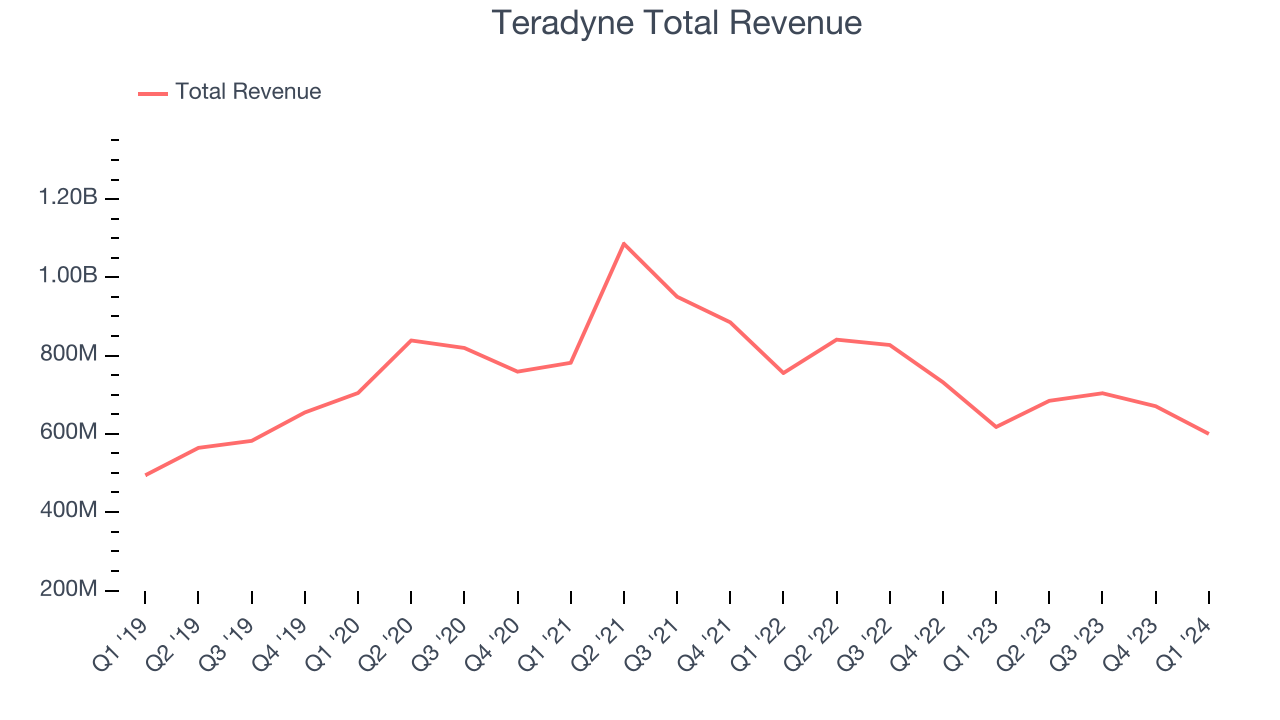
Even though Teradyne surpassed analysts' revenue estimates, this was a slow quarter for the company as its revenue dropped 2.9% year on year. This could mean that the current downcycle is deepening.
Teradyne looks like it's on the cusp of a rebound, as it's guiding to 1.5% year-on-year revenue growth for the next quarter. Analysts seem to agree as consesus estimates call for 10.8% growth over the next 12 months.
Product Demand & Outstanding Inventory
Days Inventory Outstanding (DIO) is an important metric for chipmakers, as it reflects a business' capital intensity and the cyclical nature of semiconductor supply and demand. In a tight supply environment, inventories tend to be stable, allowing chipmakers to exert pricing power. Steadily increasing DIO can be a warning sign that demand is weak, and if inventories continue to rise, the company may have to downsize production.
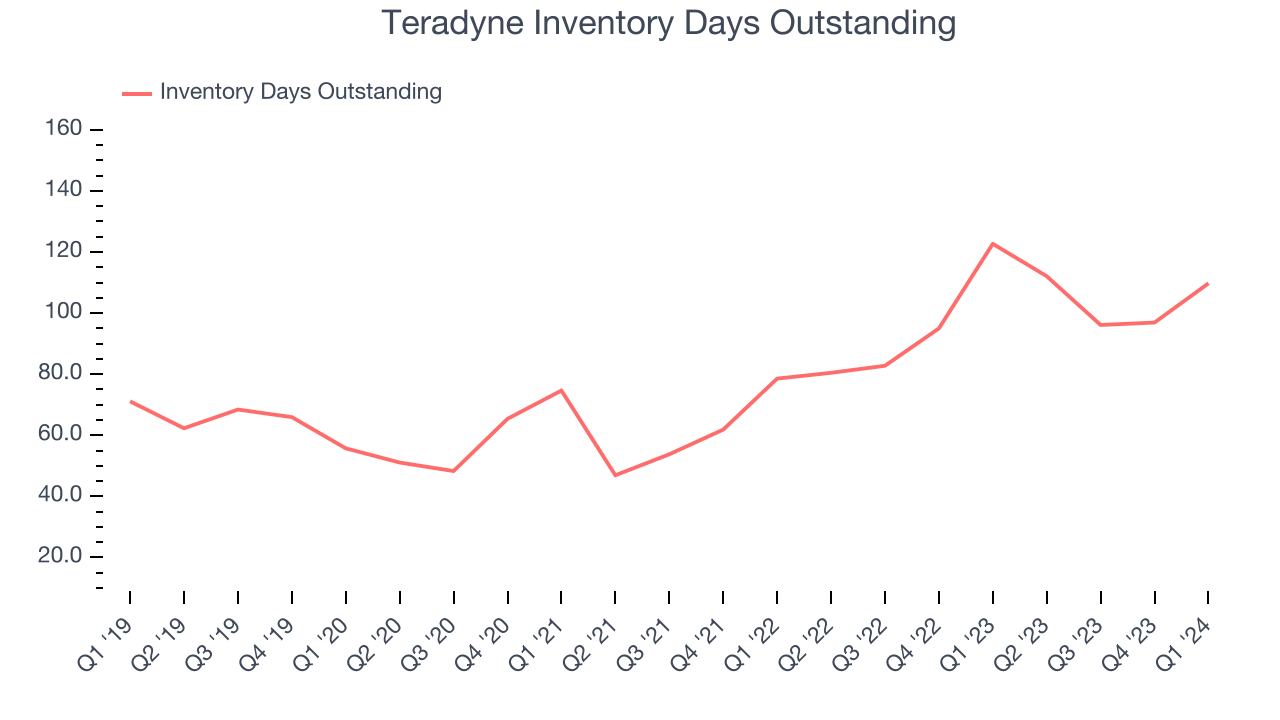
This quarter, Teradyne's DIO came in at 110, which is 33 days above its five-year average, suggesting that the company's inventory has grown to higher levels than we've seen in the past.
Pricing Power
In the semiconductor industry, a company's gross profit margin is a critical metric to track because it sheds light on its pricing power, complexity of products, and ability to procure raw materials, equipment, and labor. Teradyne's gross profit margin, which shows how much money the company gets to keep after paying key materials, input, and manufacturing costs, came in at 56.6% in Q1, down 1.2 percentage points year on year.
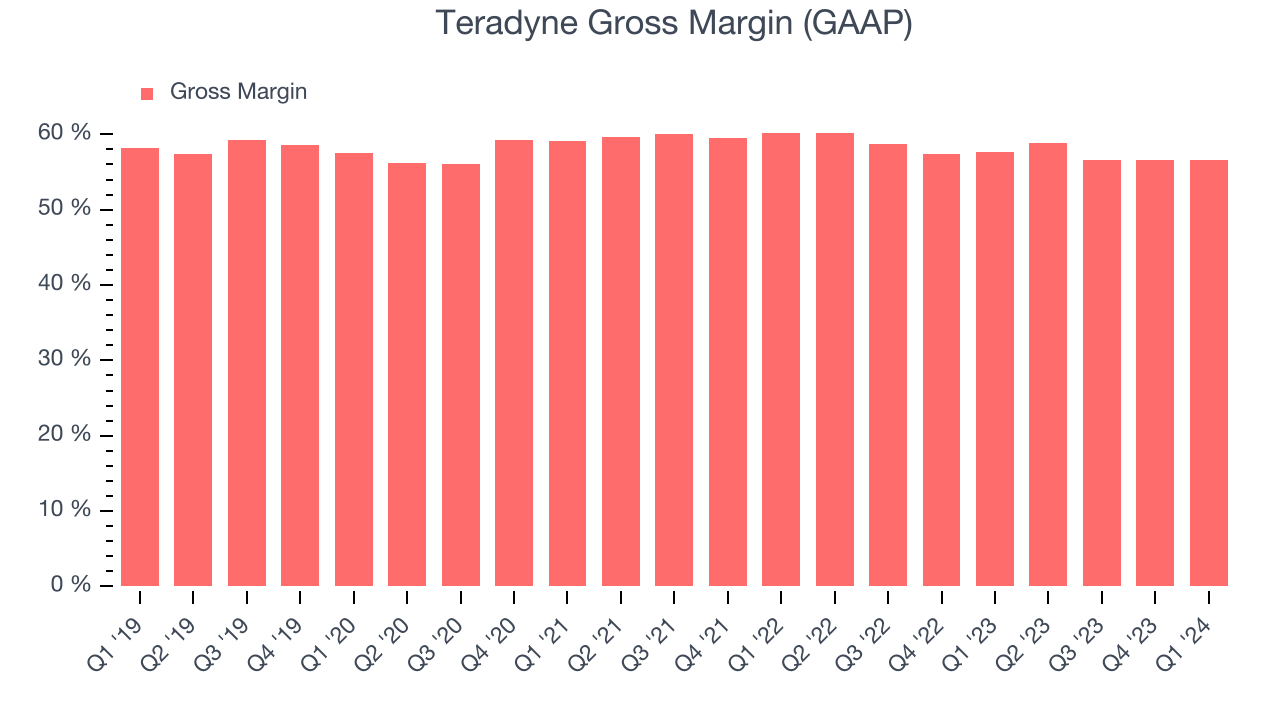
Despite declining over the last 12 months, Teradyne still retains reasonably high gross margins, averaging 57.2%. These margins point to its solid competitive offering, disciplined cost controls, and lack of significant pricing pressure.
Profitability
Teradyne reported an operating margin of 14.8% in Q1, down 2.3 percentage points year on year. Operating margins are one of the best measures of profitability because they tell us how much money a company takes home after manufacturing its products, marketing and selling them, and, importantly, keeping them relevant through research and development.
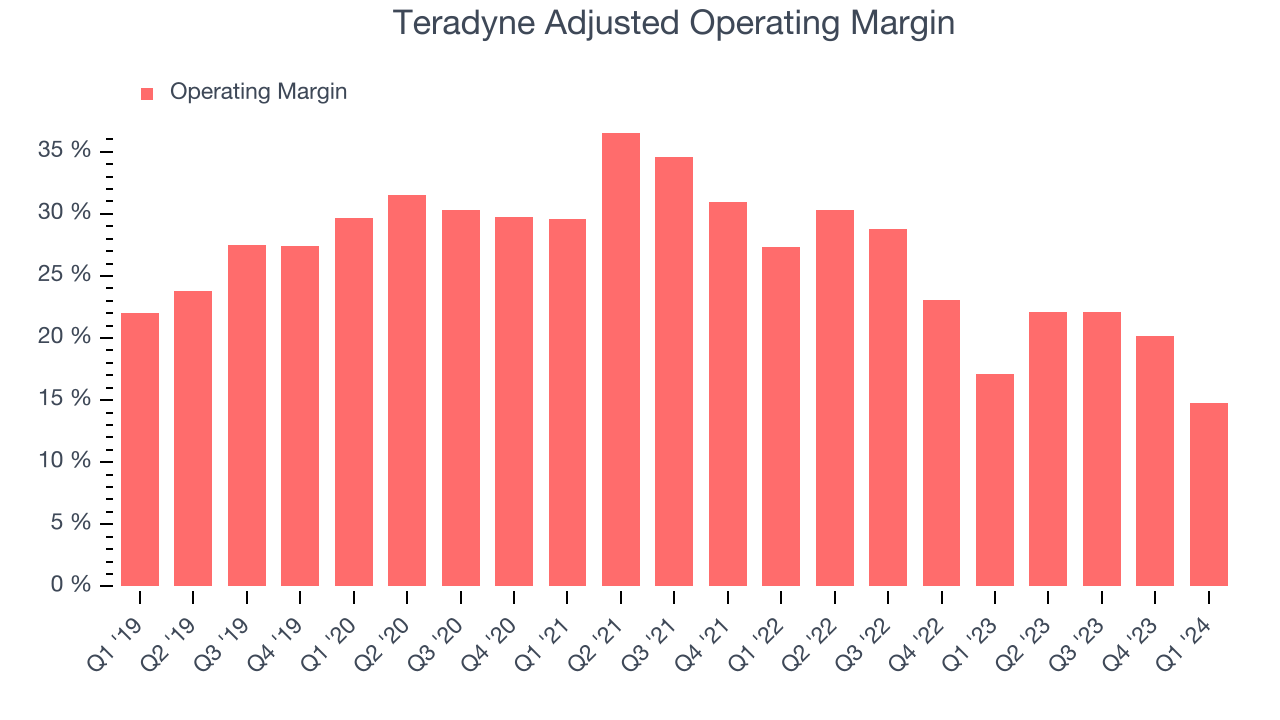
Teradyne's operating margins have been trending down over the last year, averaging 19.9%. This is a bad sign for Teradyne, whose margins are already below average for semiconductor companies. To its credit, however, the company's margins suggest modest pricing power and cost controls.
Earnings, Cash & Competitive Moat
Analysts covering Teradyne expect earnings per share to grow 25.4% over the next 12 months, although estimates will likely change after earnings.
Although earnings are important, we believe cash is king because you can't use accounting profits to pay the bills. Teradyne's free cash flow came in at negative $36.74 million in Q1, down 66.2% year on year.
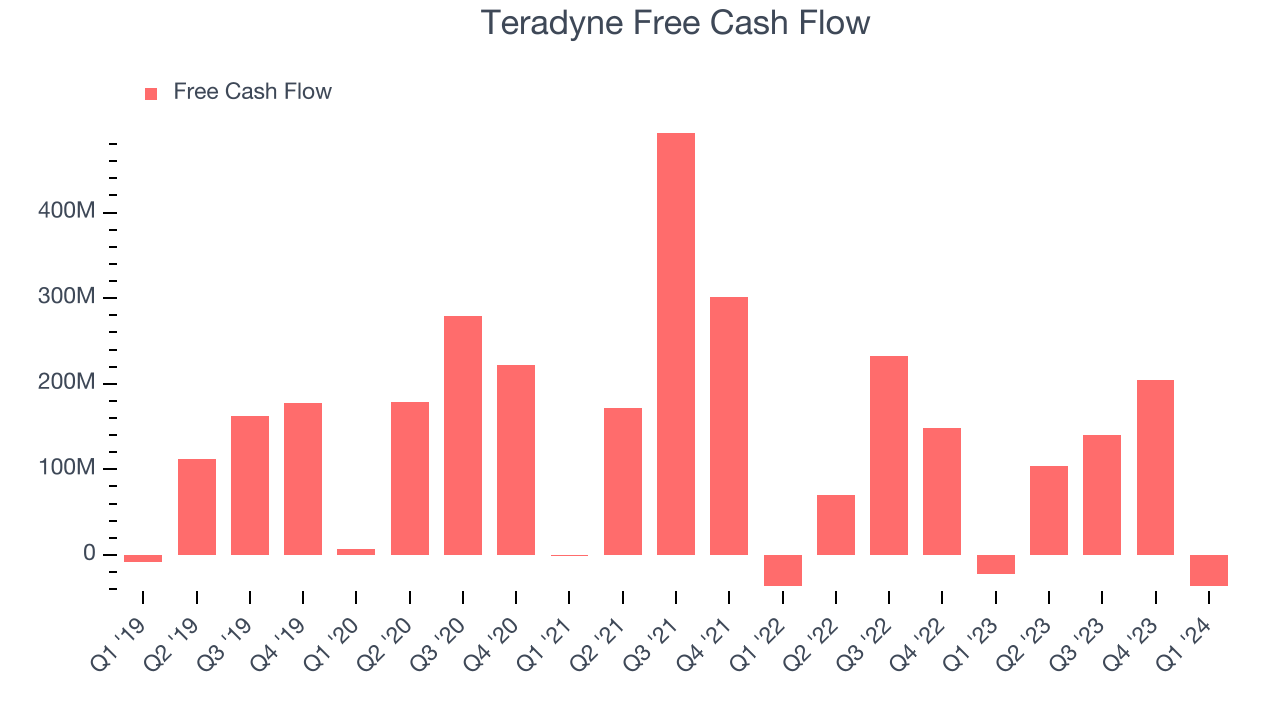
As you can see above, Teradyne produced free cash flow of $411 million in the last year, a decent 15.5% of revenue. This FCF margin puts Teradyne in a position to reinvest, but we wouldn't mind seeing its cash flow conversion improve a little.
Return on Invested Capital (ROIC)
EPS and free cash flow tell us whether a company was profitable while growing revenue. But was it capital-efficient? A company’s ROIC explains this by showing how much operating profit a company makes compared to how much money the business raised (debt and equity).
Teradyne's five-year average ROIC was 49.1%, placing it among the best semiconductor companies. Just as you’d like your investment dollars to generate returns, Teradyne's invested capital has produced excellent profits.
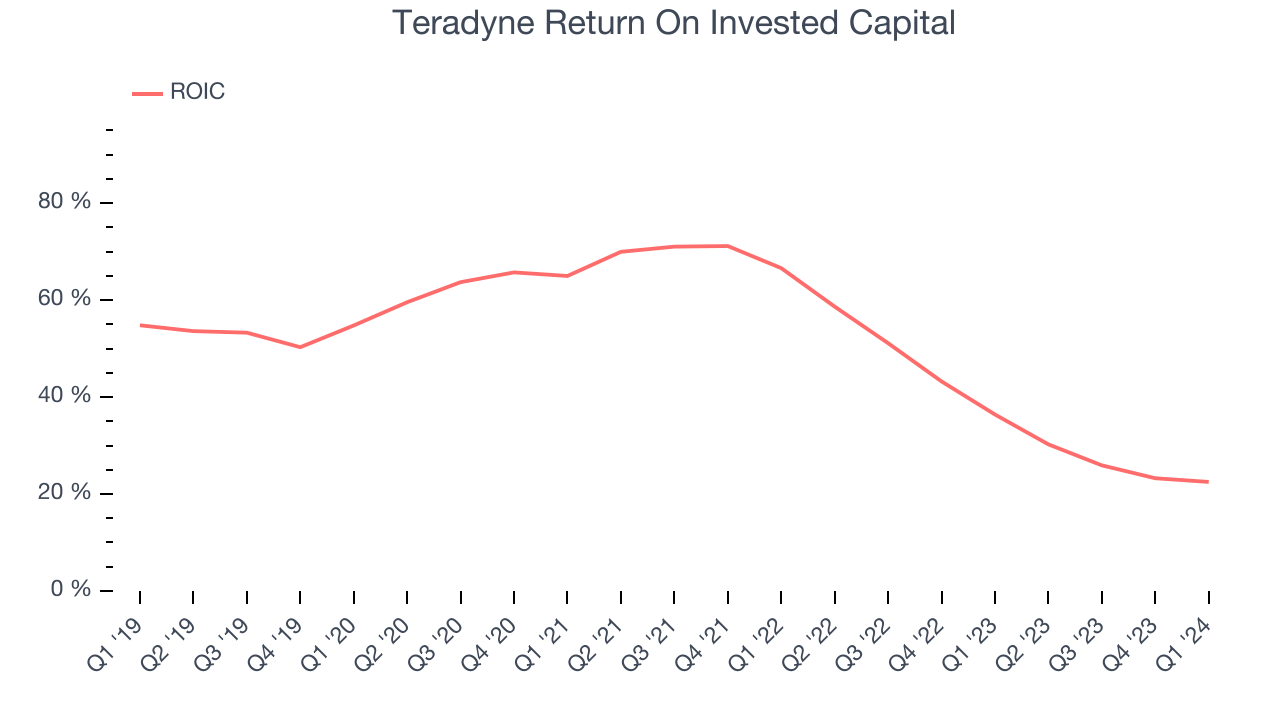
The trend in its ROIC, however, is often what surprises the market and drives the stock price. Unfortunately, Teradyne's ROIC significantly decreased over the last few years. The company has historically shown the ability to generate good returns, but they have gone the wrong way recently, making us a bit conscious.
Balance Sheet Risk
Debt is a tool that can boost company returns but presents risks if used irresponsibly.
Teradyne is a well-capitalized company with $748.7 million of cash and $82.95 million of debt, meaning it could pay back all its debt tomorrow and still have $665.7 million of cash on its balance sheet. This net cash position gives Teradyne the freedom to raise more debt, return capital to shareholders, or invest in growth initiatives.
Key Takeaways from Teradyne's Q1 Results
We were impressed by how significantly Teradyne blew past analysts' revenue and EPS expectations this quarter. We were also glad next quarter's revenue and EPS guidance was higher than Wall Street's estimates.
This quarter's strength was driven by the company's Semiconductor Test segment, which posted revenues of $412 million vs estimates of $377 million. Teradyne also saw better-than-expected demand in memory, networking, and computing solutions given the momentum in AI applications. It expects to see this tailwind throughout the first half of the year.
For the back half of the year, Teradyne expects Robotics to contribute meaningfully to growth through new products, applications, and distribution channels.
Despite all the positives, we note the company's inventory levels materially increased while its operating margin shrunk. The inventory rise could be related to Teradyne stocking up ahead of demand, but it's tough to know for sure until the company hosts its earnings call.
Overall, this quarter's results still seemed fairly positive and shareholders should feel optimistic. The stock is up 7.9% after reporting and currently trades at $108.61 per share.
Is Now The Time?
When considering an investment in Teradyne, investors should take into account its valuation and business qualities as well as what's happened in the latest quarter.
We think Teradyne is a solid business. Although its revenue has declined over the last three years with analysts expecting growth to slow from here, its stellar ROIC suggests it has been a well-run company historically. And while its operating margins are below average compared to its semiconductor peers, its gross margins are suggestive of good pricing power.
Teradyne's price-to-earnings ratio based on the next 12 months is 28.9x. There are definitely things to like about Teradyne and looking at the semiconductors landscape right now, it seems that the company trades at a pretty interesting price.
Wall Street analysts covering the company had a one-year price target of $115.57 per share right before these results (compared to the current share price of $108.61), implying they saw upside in buying Teradyne in the short term.
To get the best start with StockStory check out our most recent Stock picks, and then sign up to our earnings alerts by adding companies to your watchlist here. We typically have the quarterly earnings results analyzed within seconds of the data being released, and especially for the companies reporting pre-market, this often gives investors the chance to react to the results before the market has fully absorbed the information.
